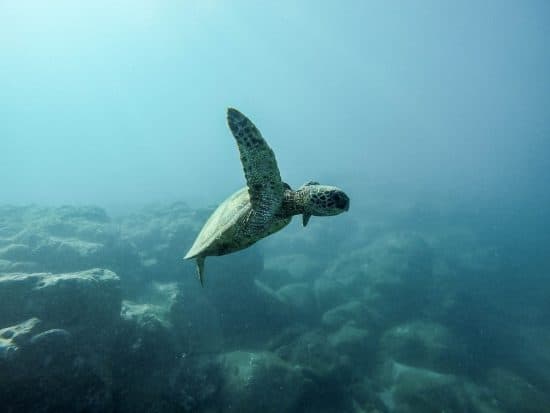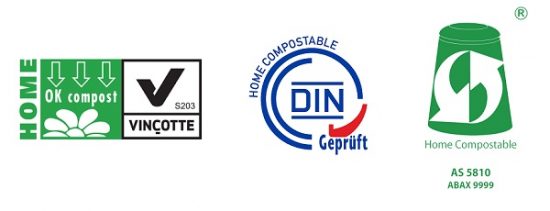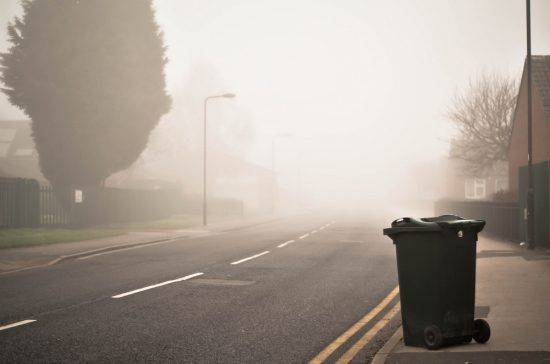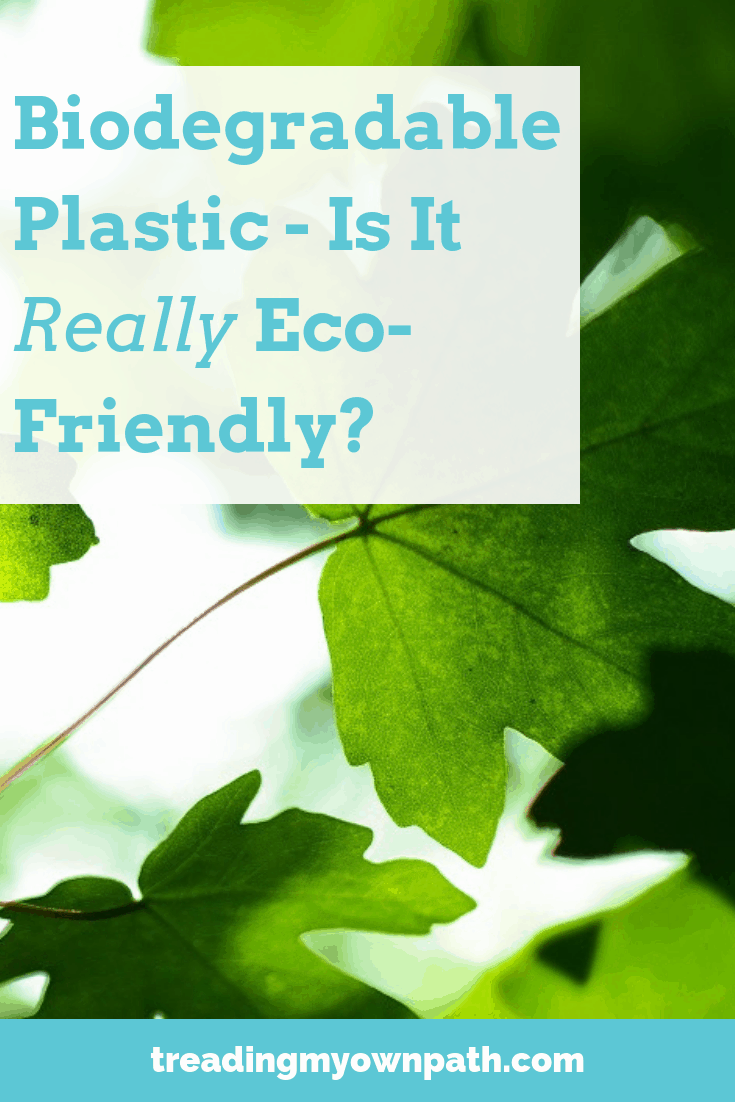Biodegradable Plastic: Is It REALLY Eco-Friendly?
If there’s one environmental claim that makes me nervous when I see it printed on plastic-like products and packaging, it’s “biodegradable”. Why? Because without context, this label is vague and potentially misleading.
A one-word label like this tells us nothing about the true biodegradability of a product. What does it biodegrade into? Toxic or non-toxic? How long does the process actually take?
Yet companies plaster it on their products in an effort to make us believe they are more eco-friendly. As customers, we gravitate towards these products, as we want to make better choices.
Of course, some companies are diligent and can back up their biodegradability claims with real evidence. But others are not.
For the average shopper, it’s hard to pick out the good claims from the bad ones.
This post will help make some sense of it all.

What Does “Biodegradable” Mean?
Biodegradation is a chemical process in which materials are metabolised into water, carbon dioxide, and biomass by microorganisms. Depending on the material, toxic residues may remain.
The process of biodegradation is influenced by a number of conditions, including temperature, humidity, oxygen levels, presence of bacteria and time.
But what does “biodegradable” mean when it’s printed on packaging, or on the label of a product?
There is actually no single common understanding or definition of “biodegradable”, so different companies will mean different things when they use this label. That makes it pretty confusing for us.
We might assume that if a product is labelled “biodegradable”, it will be non-toxic, it will break down in home compost bins, and / or it will break down quickly.
But this isn’t necessarily the case.
The good news is, if a product is truly biodegradable, the company should be able to provide details supporting this claim.
And by details, I mean scientific evidence. Not anecdotal claims by the company CEO that they put it in their home compost bin and it “disappeared”.
Real data, based on actual laboratory tests.
Biodegradable Standards: What They Are and What They Mean
Because there are no defined understanding around what “biodegradability” means, certification schemes have been developed based on scientific standards and testing.
Certification is a way for companies to back up the claims they make about the biodegradability of their packaging and/or their products with scientific data.
Whilst voluntary, these schemes are attractive to companies wanting to demonstrate environmental responsibility and safety of their products.
As consumers, knowing that the packaging / product is certified gives us piece of mind, and helps us make better purchasing decisions.
These are the standards to look out for.
Standards for Biodegradable Plastics:
There are a number of different standards for biodegradable plastics, with different certification schemes established by different certification bodies. There is currently no standard with a clear pass/fail criteria for the degradation of plastics in sea water.

Standards for home composting:
These standards are awarded to products that will break down in home composting systems.
Look out for these numbers stated on the product or packaging:
Australian AS 5810 “Biodegradable plastics – biodegradable plastics suitable for home compostingâ€.
Belgian certifier Vinçotte had developed the “OK compost” home certification scheme, requiring at least 90% degradation in 12 months at ambient temperature.
Labels proving home compostability are Vinçotte’s OK Compost Home, the DIN-Geprüft Home Compostable Mark and the Australasian Bioplastics Association (ABA) Home Compostable logo.
 Standards for industrial composting and anaerobic digestion:
Standards for industrial composting and anaerobic digestion:
These standards apply to products that will break down in industrial composting facilities or anaerobic digesters within a stated timeframe. (This is not the same as home composting, and these products may not break down in home compost bins.)
Look out for these numbers stated on the product or packaging:
European Standards EN 13432 / 14995 (13432 applies to packaging only, 14995 applies to plastics generally);
The Australian standard AS 4736 which additionally includes an earthworm test;
ASTM D6400 is the US standard with clear pass/fail criteria;
Japan has no accepted standard, but certification scheme GreenPla is widely used.
Labels proving compostability in industrial facilities are the ABA Compostable Seedling logo, the Vinçotte OK Compost logo, the DIN-Geprüft Industrial Compostable Mark, and the Biodegradable Products Institute (BPI) Compostable logo.

The catch with these products is that not everybody has access to industrial composting facilities. Even when they do, the timeframes required to break down these products (typically 90 days) are often much longer than the timeframes these facilities use per composting cycle. In short, these products may not biodegrade at these facilities and some facilities will not accept them.
Biodegradable Products Aren’t Perfect
Even where a product is certified as biodegradable, that doesn’t mean it is 100% biodegradable.
For example, for a product to comply with EN 13432 / EN 14995 standards, at least 90% of the organic material must convert into CO2 within 6 months in controlled composting conditions; and after 3 months’ composting and subsequent sifting through a 2mm sieve, no more than 10% residue may remain (as compared to the original mass).
The Japanese certification scheme GreenPla specifies the minimum level as only 60%.
“Biodegradable” doesn’t mean there are no heavy metals or toxic chemicals present. Each certification standard has its own permitted levels of metals including copper, nickel, cadmium, lead, mercury, chromium and arsenic: US standard ASTM D6400 has the highest permitted levels.
And if there’s no commercial composting facility in your area, it will likely end up in the bin.

Where possible, it’s always better to avoid packaging altogether.
Is “Biodegradable” Labeling Regulated by Law?
With no mandatory standards on biodegradability: however, there are guidelines about how the term “biodegradable” (and other environmental labels) can be represented so that they do not mislead consumers.
In Australia, the Trade Practices Act (1974) requires businesses to provide consumers with accurate information about goods and services. Businesses that make claims such as biodegradable on their packaging must ensure these claims can be substantiated. It’s the law.
Being able to substantiate claims is particularly important if the claim predict future outcomes, such as whether plastics will biodegrade or within a certain timeframe and under certain conditions.
Claims about biodegradability must:
- Be honest and truthful;
- Detail the specific part of the product or process referred to by the claim;
- Use language the average member of the public can understand;
- Explain the significance of the benefit but not overstate it;
- Be able to be substantiated.
In Australia, the ACCC (Australian Competition and Consumer Commission) has taken action against a number of companies making misleading claims about biodegradability, including supermarket chain Woolworths.
Biodegradable Plastics: A Summary
Companies make unsubstantiated claims about biodegradable products all the time, sometimes deliberately but sometimes because they have a limited understanding of what it really means. Certification schemes are one way for us as consumers to pick out the good guys from the shady ones.
A product saying it’s “biodegradable” should specify what percentage the biodegradable content is, how long it take to break down, what it will break down into, and what conditions it needs to do so. (That’s what the certification labels are telling us.)
Look for products labelled “Home Compostable” first.
Bear in mind that even products that can be composted industrially may still end up in landfills, and biodegradable plastics do not break down in the marine environment. A plastic bag will still look like a jellyfish to a sea turtle, whether it’s certified biodegradable or not – and biodegradable does not mean digestible.
If biodegradable packaging ends up as litter, it can be just as destructive and harmful as conventional packaging.
Certified biodegradable plastics are better than non-biodegradable ones, but they are not the perfect solution. Refusing, reducing and reusing are always better options, where we can.
[leadpages_leadbox leadbox_id=1429a0746639c5] [/leadpages_leadbox]







Best avoid all types of plastic as much as possible, as none is probably 100% safe.
Just reading “Review of standards for biodegradable plastic carrier bags” from UK’s http://www.gov.uk/defra site,
– not enough is really known about biodegradable plastics or the way they breakdown in different types of environments and how long that will take to happen!
I totally agree, Bob! I think these plastics are better than fossil fuel based plastics, but the answer will never be single-use – at least not for everyday. Clearly emergencies and natural disasters are different, but as a society we can come up with better solutions to avoid these altogether :)
Great post. Very informative.
Thank you! :)
My husband’s joke is our recycle bin probably ends up in the landfill. I hope at least some of it is reused. In my local area, people are trying to come up with “upcycle” ideas, such as making art out of plastic bags or tin lids; but it just won’t keep up with the use and abuse we do on a daily basis.
I hope not Patti, that’s not funny at all! :/ I’m sure some of it is. The metal most likely, and paper/cardboard – they are the most valuable things (at least here in Perth/Australia). I know what you mean about the upcycling efforts – nice idea (sometimes amazing) but just not keeping up with the flow of more and more material!
Biodegradable does not mean a quick fix to litter which may still end up in waterways having the same effect on marine life. A biodegradable item needs oxygen to help it break down (toxic or not) – burying it in land fill is exactly the same as ‘real’ plastic
Exactly Phil – and exactly as I said! :)
I LOVE all of your posts! Thanks for this. I had been meaning to research it for some time now.
Thank you Cari, I’m so glad! :)
I’ve had two one-use plastic cups sitting side by side for several years now. One normal plastic, the other billed as biodegradable. Because sun and water are supposed to be keys to biodegrading them, they both contain water and soil and sit in the sun. There has been no discernible degradation.
Hi Ruth, love it – experiments in action! (Well, except I don’t love the results of course.) That’s the thing with “biodegradable”, there’s often lots of other conditions required. Like hot temperatures, and specific bacteria. Which might be present in a hot composting facility but generally not many other places. Seems like not on your window sill for example! :/
In the USA, there are lots of jargon on plastics that has lead to some costly legal settlements when companies were found guilty of misleading claims. Some states have banned use of these terms for fear of more litigation. At least the labels raise awareness of the plastics problem. Maybe someone who see it on a label will look it up. How can we standardize the meaning? At least in one country? The problem is global – maybe we need a global definition?
Hi Jeanne, thanks for your comment. I wish these terms were banned, or at least legislated properly as people want to believe things are biodegradable/compostable/good for the planet, and generally assume a company will have looked into it. But they get materials from other suppliers, who might source from others again, so messages get confused and misinterpreted. Bioplastics rarely (ever) have 100% compostability, yet companies say that their products are. So even these statements don’t align with the actual certification. Plus some companies pretend that bioplastics aren’t plastics (um…yes they are, the clue is in the name). Same material, different raw material. Same pollution and litter issues. Natural materials are so much better…and reusables, of course!
Thanks Lindsay for this fabulous post.
My pleasure Jo! :)
It was just on the news yesterday about a survey commissioned by our government (Sweden) which states that biodegradable plastic bags are sold under false pretences – there are in fact no plastic bags that are100% biodegradable sold in Sweden. They all leave some residue and the suggestion is that producers of these products should be compelled to inform their customers of this.
Love it – go your government! This is one of the issues. Certified compostable DOES not mean 100% compostable (some certifications say 90% is enough, GreenPla say 60% – and this is the certification typically found in those “cornstarch” teabags that companies want us to think are green and eco-friendly). I’m not sure if you clicked the link in the article to show all the levels of heavy metals permitted – yuck! I’d rather have my compost (and teabags) heavy metal free, thanks. I wonder if your government will legislate – I hope so!
Another thought – a while ago there were some “breaking news” about some caterpillars that were able to breakdown plastic but they never said what the plastic was turned into – probably just smaller particles, which doesn’t solve the problem. Plastic is still there even when it no longer looks like a bag!!! And that is probably even worse because as long as it looks like a bag, people will look at it as rubbish (and hopefully dispose of it so) but if it looks like soil they will think the problem is gone – out of sight is out of mind and all the while micro plastics keep seeping out into the environment…
There’s been talk of this for years (I know because I studied biochemistry at university, and I remember it being talked about back then). The trouble is, the amounts they’d eat is so tiny, it’s not a practical solution. And to figure out what’s going on (from a science point of view), isolate those genes, somehow manipulate them to be more effective (eg put into bacteria), test that we’re not going to pollute /contaminate /poison something else and make it economically viable – well that’s a long way to go!
I also find the idea that we can just wait and science and invention will “solve” the problem to be a scary idea – one that says, it’s business as usual because we can invent the solution later. Maybe that’s true, but more likely not! And what about all the wildlife being killed, floods due to plastic bags blocking drains etc in the meantime?!
Yes! These labels are often misleading and when I see a paper tea bag lined with plastic and it says it can be composted…my eyebrow says, “Hmmmdon’tthinkso!” This was a greatly timed post; I put the pic of the bag on my Instagram and asked others about it, but there seemed to be no clear answer. The “compostable” ASTM D6400 film is made from Ingeo polymer, which is made from plants. But to me that sounds crazy… a plastic film made from plants? I didn’t trust to compost it, so I didn’t :( I Googled it and found a video that was supposed to explain it, but the positive sounding woman just made me more skeptical (it was a video from the company that makes it).
Hi Nadine, thanks for you’re comment. Ooooh, don’t get me started on the compostability (or lack of) of teabags issue, I’m planning a post around that! ;)
Ingeo is one of the biggest bioplastic manufacturers, but it isn’t the only one. So yes Ingeo plastic is certified to ASTM D6400 but that doesn’t mean that a plastic that is certified ASTM D6400 is definitely Ingeo. That’s the plastic that we often see with those “compostable” smoothie cups and salad bowls, the clear colourless ones? Well interesting fact, Ingeo is actually yellow, but as customers want clear/colourless, they put in an additive to make it so. But what that additive is, not sure…
Yes, it’s made from plants (but actually, so are fossil fuels if we’re being technical about it). Being made from plants isn’t a guarantee that it will compost. People assume bioplastics will biodegrade but that isn’t necessarily true.
Ingeo plastic has been tested at least. ASTM D6400 states it will break down by 90% in 90 days in hot composting conditions in the presence of bacteria. So what happens to that other 10% and what exactly it breaks down into (microplastic?) is less clearly defined.
The other question is, where are these hot composting facilities that are operating for 90 days? Here in Perth we have two hot composters, and they run a cycle for two weeks, not 90 days. So they will still be spitting plastic out at the other end. Many of these facilities actually say they don’t accept compostable plastics as they won’t break down in the timeframes.
So short answer: it won’t break down in your home compost. It will break down in a hot composting commercial facility, into what exactly is not entirely clear and will include residue (which may or may not include heavy metals). Not exactly a green solution! (PS If you want to email me a pic of the teabag and any packaging, I’d be super interested!)
Thanks for the response! I sent you the pic via instagram; it’s the bottom of the bag. I’m glad you have simplified it for us and thanks for doing the research. I definitely didn’t put it in my home compost, as I simply didn’t trust it. At this time we do not have local composting facilities (boooooooo).
FYI, the Trade Practices Act 1974 (Cth) was repealed and replaced by the Competition and Consumer Act 2010 (Cth), which contains the current rules about misleading and deceptive conduct in trade and commerce. “The Australian Consumer Law” is Schedule 2 of the Competition and Consumer Act: see http://www.austlii.edu.au/cgi-bin/viewdoc/au/legis/cth/consol_act/caca2010265/sch2.html
hi i`m bella when is the publication of this?
Thanks for your post, Its nice one.
Other ways can we use the non woven bags?.
Your topic is very good and informative. Keep up this Great work. It will be so much helpful in favor of my knowledge.
very very nice post
Hi Lindsay.
Some information in my country said:
Biodegradable Plastic bags in the process of decomposing them release methane – a powerful that create greenhouse effect.
Right or wrong ?
excellent article making sense of the greenwashing scam of biodegradable.
Hi Lindsay, do you know anything about Biobags? They say they are “fully compostable and biodegradable” – are they really compostable? Do they leave a toxic residue? They have the “vincotte” logo saying Ok to compost and ok to home compost, but no AS numbers…
Thanks so much for putting this information forward!
Hi Lindsay. Great post to clear up the confusion a little bit.
What about the problem when bioplastics get thrown into a recycling bin. What happens to the plastic rencyling batch – will it be ruined and has to be thrown out?